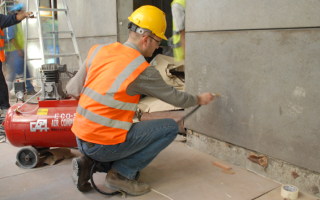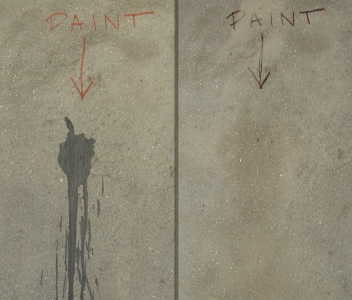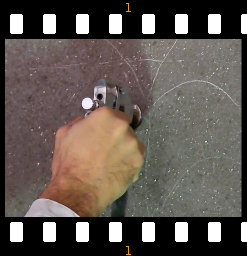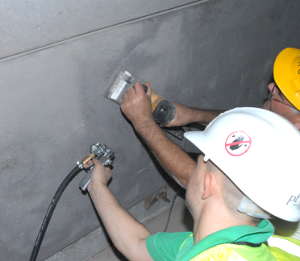Maintenance
This document describes some maintenance and repair methods for the Montmorency Coating, in cut and sandpapered finishes.
The details of the technical terms are at the end of the document (General section).
Dust and dry marks
| Before | After |
 |
To remove dust and/or dry marks, use dry compressed air at greater than 6 bar.
The wall surface should be dry.

Thick marks
| Before | After |
 |
To remove thick marks (plastic paint, mastic, ...):
- Remove the marks with a razor.
- Remove the dust and residue as described above.
Surface flaws

To remove surface flaws (writing, felt pen marks, various stains, finishing flaws (scrapes, tool marks, smooth patches, …), scratches):
- Remove the dust.
- Sand the affected area (only) by hand.
- Remove the dust again.
- If required, sand lightly with a sanding machine to a uniform finish, then remove the dust.


Missing material
To repair areas where material is missing (impact marks, damaged edges, …):
- Prepare the edges of the area to be repaired (make the edges vertical).
- Remove the dust.
- Thoroughly wet the area.
- Mix the same product as originally used.
- Fill the area with a "cat's tongue" trowel, taking care not to spread material onto the undamaged area.
- When hardened (wait until the hardness of the original material has been attained), scrape (or scratch) to the original level.
- Scrape the edges of the repair (areas made smooth by the new material).
- Allow to dry completely (several days).
- Remove the dust.
- If required, sand lightly with a sanding machine to a uniform finish, then remove the dust.
Significant repairs
- Straighten the edges: make the area rectangular.
- Remove the dust.
- Protect the edges of the area with masking tape.
- Chamfer the edges.
- If required, prepare the background (bonding agent, mesh, ...).
- Thoroughly wet the area, especially the edges.
- Mix the same product as originally used.
- Fill the area with a small trowel.
- When hardened (wait until the hardness of the original material has been attained), scrape (or scratch) to the original level.
- Remove the masking tape.
- Scrape the edges of the repair (areas made smooth by the new material).
- Allow to dry completely (several days).
- Remove the dust.
- If required, sand lightly with a sanding machine to a uniform finish, then remove the dust.

General retouching/renovation

General retouching is intended to correct widespread finishing faults, effects of ageing, pollution, ...
- Check that the coating is completely dry everywhere.
- Sand the whole area with a sanding machine.
- If certain parts are set back, sand them by hand.
- Straighten the edges with a "chemin de fer".
- Remove the dust.
- During the work, alternate sanding and dust removal to check the progress.
- Moisten the entire area by misting (avoid run-marks).
General
- The dust removal should be done on dry areas and use dry compressed air at greater than 6 bar.
- The sanding should be carried out dry with grade 40 to 120 sand paper, according to the grain of the coating.
- The scraping should be done with the straight edge of the berthelet, held at a right angle to the surface.
- Sharpening of the berthelet should be done with an electric file.
- Wetting surfaces should be carried out with clean water, until no more is absorbed.
- Filling should be done from the centre towards the edges in thick layers.
- The cutting should be done with an angle grinder with a diamond cutting disc.
- The edges of the repair areas should be protected by a double layer of masking tape, wider than the blade of the berthelet.






